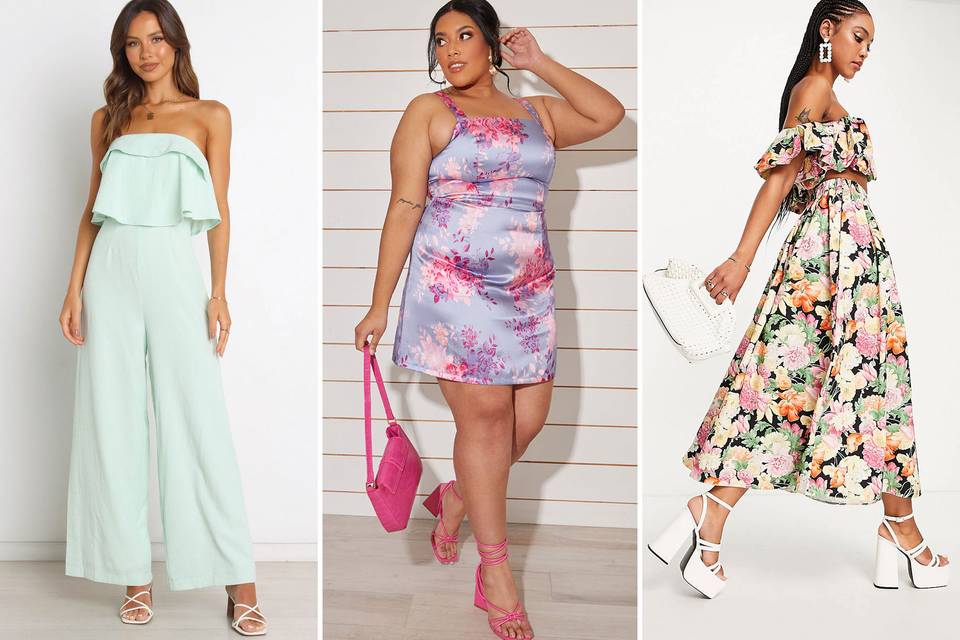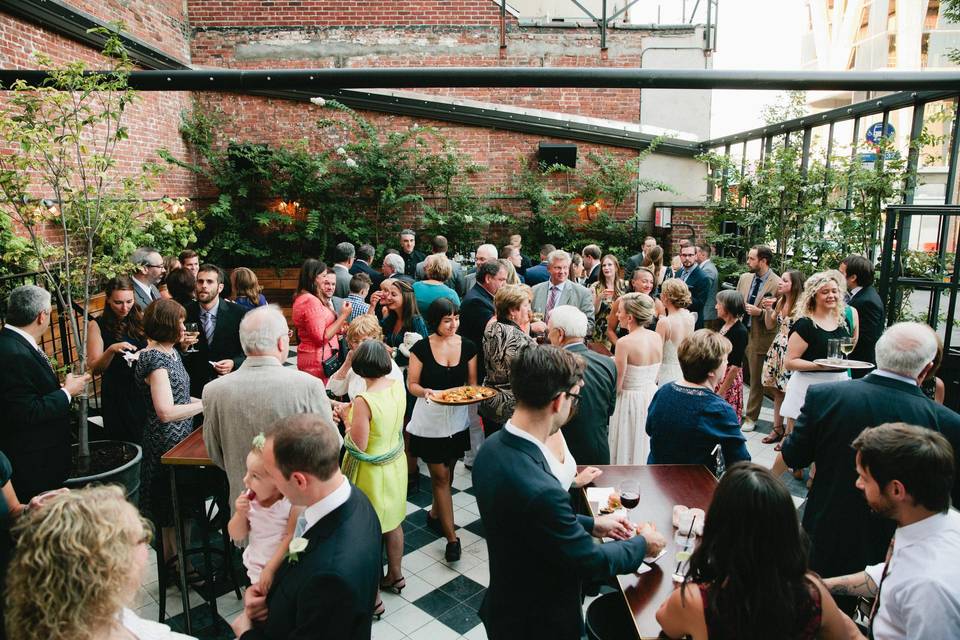9 Wedding Guest Dress Codes and What They Mean
If you just received a wedding invitation in the mail, bookmark this wedding dress codes guide to make sure you're dressed appropriately for the occasion.

Decoding wedding wardrobes has forever been a point of stress for couples, but if you're a wedding guest, chances are you'll be faced with the same issue sooner or later. Wedding dress codes have become slightly more complicated over the years, as many weddings veer away from ultra-formal attire and in favor of a more casual or laid-back approach for the big day. Once and for all, it's time to button things up with this helpful guide to the most common wedding dress codes that you're likely to encounter during wedding season. If you're getting married and trying to finalize your dress code, we'll help you make the call between cocktail attire or black tie. Attending a wedding instead? This will help you figure out exactly what to wear, whether you're heading to a barn reception or a swanky ballroom venue. Keep reading for the rundown of what to wear, from the most casual dress codes to extremely formal attire.
Beach Wedding Attire
Because of their waterfront setting (and the potential sand involved), beach weddings are naturally more casual. Unless the invitation specifies a formal or cocktail dress code, you can plan to dress a little more comfortably—but skip the board shorts and bathing suit cover-ups, please! Wearing bright colors and whimsical prints are two of the best things about beach wedding attire, since they'll play up the tropical vibes of the day. Focus on lightweight fabrics, like linen and cotton, which not only work with the informal setting but will keep you cool in hot temperatures at a summer wedding. Breezy, flowing gowns and skirts are definitely appropriate for a beach wedding dress code, and if you're wearing a suit or sport coat, a tie is optional. When it comes to shoes, avoid flip flops unless you know for sure that it's a very casual wedding. Instead, we'd recommend a pair of dress sandals, loafers, boat shoes, wedges, or block heels.
Dressy Casual or Daytime Attire
If you've received an invite that says "dressy casual," you're more than likely wondering what it means and exactly how casual is too casual. One of the first things you should consider is where the wedding is taking place. Is the couple getting married outdoors in their backyard or at a local park? If so, you can take a more informal approach when it comes to choosing your outfit. Elegant sun dresses, button-down shirts, and dress pants are all appropriate outfit ideas under a casual dress code. For an indoor venue, such as a banquet hall or house of worship, basic suits and modest looks (for example, dresses with sleeves) are your safest bet.
The next thing to consider is the time of day—morning and daytime weddings are much more casual than evening weddings. Finally, go with an outfit that's more dressy than what you would usually wear in an everyday setting (that means no jeans and athleisure). A good rule of thumb is to aim for something you'd wear for a job interview—you want to look put-together, but you also want to be yourself. When it comes to shoes, opt for loafers, brogues, classic high heels, ballet flats, or dressy sandals.
Semi-Formal Attire
This wedding dress code is a step up from dressy casual attire, but not quite as bold as cocktail attire or as fancy as formal attire (i.e. black tie and black tie optional). When dressing for a semi-formal wedding, aim for understated and elegant looks—think streamlined blazers, dress shirts, pantsuits, midi dresses, and simple accessories. Classic hues, like navy blue, burgundy, and black, are some of our favorite go-to colors for semi-formal attire.
Cocktail Attire
Heading to a cocktail attire wedding? Get ready to have some fun with your look! While this is one of the more formal wedding dress codes, it also allows you to play around with bright colors, statement accessories, and bold embellishments. Cocktail attire is all about creating a party-ready look while keeping it classy. For dresses, cocktail-length is a must—that means a knee-length hemline or something longer that hits above the ankles. A trusty LBD always works (and if you don't have one, this is a great time to invest). If you don't want to wear a dress, a tailored jumpsuit is a chic alternative. Men should wear suits, preferably in dark blue or black, paired with a traditional white shirt. High heels or dress shoes will complete your look. Finally, it's time to add accessories, which is where the cocktail attire theme can really shine. Bedazzled clutches, patterned ties and colorful bow ties, and eye-catching jewelry will give your ensemble a final bit of pizzazz and personality.
Black Tie Optional Attire
We'll get to traditional black tie attire in a second—but first, let's break down this slightly less formal (and slightly more confusing) wedding dress code. A black tie optional wedding is basically suggesting that you should wear black tie, but it's acceptable if you don't. So what does that mean, exactly? Men can wear dark suits (think: your very best suit, preferably black and custom-tailored) instead of the tux that's required for actual black tie weddings. Women can wear very fancy cocktail dresses instead of floor-length dresses, but avoid anything with revealing cutouts or hemlines above the knee.
Black Tie Attire
For a black tie wedding dress code, imagine that you’re going to the Oscars, a gala, or other red carpet event. It’s time to really lean into the formal look when it comes to this wedding dress code. Women should wear floor-length gowns made from fabrics like silk, satin, crepe, chiffon, or beading. High heels are preferred, but fancy ballet flats or wedges are also appropriate (avoid open-toe flats and sandals). Men must wear full tuxedos, including the jacket, tuxedo shirt (yes, there's a special kind), cummerbund, black bow tie, cuff links, and matching pants with a satin stripe. If you don't have black patent leather shoes, most tuxedo rental companies will provide them. Beyond your attire, think about your hairstyle and other grooming—facial hair should be neatly trimmed, long hair should be styled, and makeup should be relatively understated.
White Tie Attire
This wedding dress code is the most formal of them all—and the most rare. It's something typically reserved for extremely fancy events, like White House banquets, state dinners, and royal weddings. Men traditionally sport a tailcoat, white vest, white bow tie, and sometimes gloves or a top hat. Full-length ball gowns, high heels, and glamorous jewelry are the norm for women's white tie attire (and don't forget your diamond tiara).
No Dress Code
Lastly, if there’s no dress code mentioned on the wedding invitation or wedding website, it's normal to feel puzzled. But as long as you follow a few simple etiquette rules, you'll be in the clear no matter the setting or venue type. First and foremost, you can rule out super-formal attire like tuxedos and evening gowns, since the couple would have specified a black tie dress code if that were the case (trust us). Second, don't wear white, especially if you're wearing a dress. Even if there's no bride—or you're not sure if the bride will actually wear a white dress—it's best to avoid this color altogether when attending a wedding. Finally, follow the rules for a dressy casual or semi-formal dress code, which are the sweet spots when it comes to looking polished but not too fancy.





